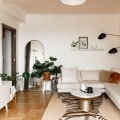Neutral color schemes have been gaining popularity in the world of interior design, and for good reason. These colors, often described as muted or earthy tones, are incredibly versatile and can bring a sense of calm and balance to any room. Whether you're going for a modern, minimalist look or a cozy, rustic vibe, neutral colors can be the perfect foundation for your design. If you're looking for inspiration for your next home decor project, consider visiting a Home Decor Store near Nexton SC. In this article, we will explore the power of neutral color schemes and how you can use them to create a beautiful and inviting space in your home.
From choosing the right shades to incorporating different textures and patterns, we'll cover everything you need to know about decorating with neutrals. So grab a cup of coffee, get comfortable, and let's dive into the world of neutral colors in interior design. To start, let's define what we mean by neutral colors. In short, neutrals are colors that are not on the color wheel - think whites, grays, browns, and black. These colors often serve as a backdrop for more vibrant shades, but they can also stand on their own as a chic and sophisticated choice for home decor. When it comes to incorporating neutrals into your space, there are a few key points to keep in mind.
First, consider the amount of natural light in each room. Darker neutrals may work well in a room with lots of natural light, while lighter neutrals can help brighten up a darker space. Second, think about the overall mood you want to create - warm neutrals like beige and taupe can create a cozy and inviting atmosphere, while cooler neutrals like gray and white can give off a more sleek and modern vibe. Lastly, don't be afraid to mix different shades of neutrals together for a layered and textured look.
Trends in Neutral Color Schemes
Now that you have a solid understanding of neutral colors, let's take a look at the latest trends in interior design and room decor using neutral color schemes.Understanding the Basics of Neutral Colors
Neutral colors are often described as being without color, but in reality, they are a combination of different shades and undertones that create a sophisticated and versatile color palette.Understanding the basics of neutral colors is essential for incorporating them into your home decor. The most common neutral colors include shades of white, beige, grey, and brown. These colors can range from cool to warm tones, which can create very different moods in a space. For example, cool tones like grey and blue can create a calm and serene atmosphere, while warm tones like beige and brown can bring a sense of warmth and coziness. When choosing a neutral color scheme for your home, it's important to consider the undertones of each color. Undertones are subtle hints of color that can be found in every neutral shade.
For example, a beige with a pink undertone will have a warmer feel compared to a beige with a yellow undertone. It's crucial to pay attention to these undertones when selecting your colors to ensure they complement each other and create a cohesive look. Another factor to consider when working with neutrals is the intensity of the color. While neutrals are often thought of as being light and muted, they can also come in deeper and richer shades. This allows for versatility in creating contrast and depth within a neutral color scheme. Neutral color schemes are a timeless and versatile choice for any home.
With the ability to create a sense of balance, sophistication, and warmth, neutrals should not be overlooked when it comes to decorating your space. Whether you opt for a monochromatic look or mix and match different shades, incorporating neutral color schemes into your home decor can add a touch of elegance and sophistication. So go ahead and embrace the power of neutral!.


